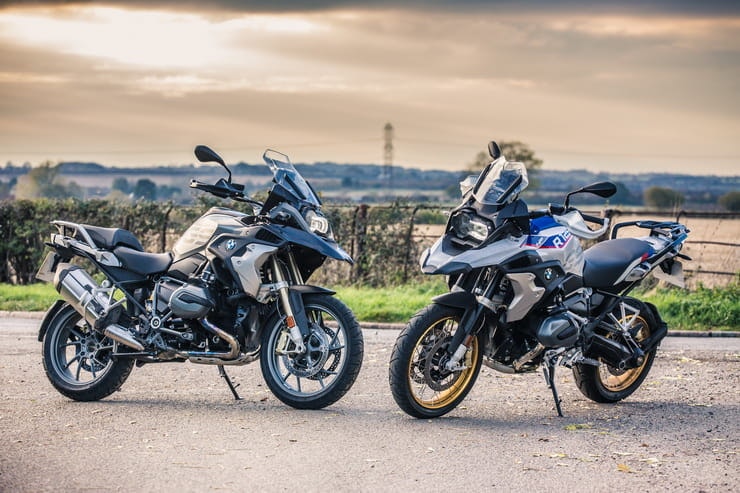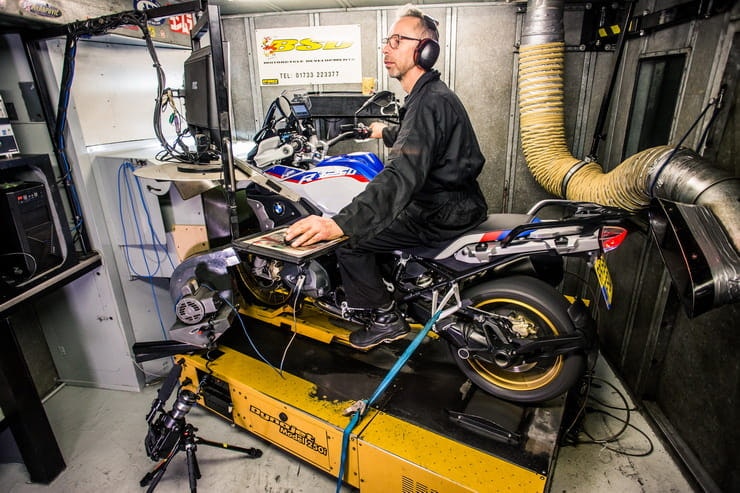BMW R1250GS (2019) - Review | World first dyno and speed test
BikeSocial Road Tester
05.11.2018
KIT CREDITS - Michael Mann
Helmet
AGV AX-9 (Matt Carbon), £439.95 | www.agv.co.uk
Jacket
Dainese D-Cyclone Gore-tex, £679.95 | www.dainese.com
Trousers
Dainese D-Cyclone Gore-tex, £429.95 | www.dainese.com
Boots
Dainese Freeland Gore-Tex | £199.95 | www.dainese.com
Gloves
Dainese Universe Gore-tex, £189.95 | www.dainese.com
BMW’s R1250GS is the most important bike of 2019. It might be the most important bike of the next ten years.
Its predecessor, the R1200GS, is the most popular bike of the last decade by some margin; BMW have sold hundreds of thousands around the world since 2004, and owners have ridden them round the world too.
And even if you don’t like or aren’t interested in the 1200GS – and plenty prefer the triple power of Triumph’s Tiger 1200, the passionate embrace of of Ducati’s Multistrada 1260 Enduro or the loopy performance of KTM’s 1290 Super Adventure (and lots of people don’t actually like any adventure bikes, which is of course perfectly fine) – there’s no denying the GS’s pivotal role in the health and wellbeing of motorcycling as a whole. It matters.
Which is why its replacement is so critically relevant (even more-so when you consider the same motor will also be powering the 2019 R1250RT and,we understand, the R1250R, R1250RS, of course the R1250GS Adventure. If BMW cocked the new GS up, we’d all be the worse for it.
The significant update to the 2019 GS is its 1254cc engine. It’s bigger, torquier, more powerful, faster, more efficient and more variable-valve timed than the R1200GS. But its chassis, suspension ergonomics and equipment are all roughly as before (for a full description of the new 1250 engine, including its Shiftcam valve timing system, click here)
So how the new 1250GS motor measures up compared to the outgoing 1200GS is very much the focus of interest: how much power and torque it makes, the nature of its delivery, its fuel efficiency – and how fast it goes.
To find out, we’re comparing a2019 R1250 GS (in Rallye trim) witha2018 R1200GS (in TE Executive trim). The tests will be: top speed, standing start quarter mile acceleration, top gear roll-on performance, hard braking and fuel consumption tests, followed by power and torque on a dyno, and finishing with a look inside the new 1250 engine itself.
Watch as we dyno and speed test the R1200GS vs R1250GS
We take the successor to the King of the Sales Chart throne and pitch it against its outgoing sibling
Performance Testing
It’s a warm, still, dry day at Bruntingthorpe Proving Ground in Leicestershire; perfect weather for performance testing. We’re speed testing using RaceLogic’s VBOX Sport, a compact GPS-based datalogger and lap timer, ideal for basic track and performance recording.
The first runs are with the R1200GS, followed by the 1250. The tests are carried out in the same order, the same number of times, with the same rider, yours truly (wearing an adventure suit), and the same fuel load.
BMW R 1200 GS vs BMW R 1250 GS - Standing start, acceleration and top speed
New 1250cc motor out-muscles the old 1200 off the line, but especially above 100mph.
With a bigger engine making a claimed extra 11bhp on identical gearing, the R1250GS should record a higher top speed than the 1200 – and it does, beating it by a mere 2.6mph. But of course, top speed isn’t the story, it’s how quickly the new engine gets there.
Both bikes are relatively easy to get off the line, even for someone as ham-fisted at standing starts as I am, and both are equipped with BMW’s slightly lazy quickshifterso it’s a simple job to hold the throttle open and rip through the gearbox into top. Both bikes are extremely stable accelerating and at top speed.
Up to 80mph under all-gear acceleration, the old and new bikes are closely matched. The 1250 feels significantly quicker, driving forward harder and making more thrust at the rear wheel.And it is faster, but we’re talking a few bike lengths in real terms, and certainly within reach of a botched launch. If you’re handy getting off the line on your 1200GS, chances are you’ll still beat your useless mate on his new 1250.
But the longer your drag race goes on – say, much above 80mph – then the 1250’s extra muscle starts to tell and it pulls clear as the 1200 runs out of puff. By the time the 1200 staggers over 120mph, the 1250 is already disappearing into the distance. Round One to the new R1250GS.
BMW R 1200 GS vs BMW R 1250 GS - Top gear roll-on acceleration
Single-gear flexibility is where the new 1250 motor really shines against the 1200.
Compared to top speed and drag race starts, top gear roll-on acceleration is much more relevant to road riding; it’s the area of performance we use most often and is great at revealing which engine have broad spreads of power allied to well-matched gearing.
In all top gear roll-ons, from any speed to any other speed, the new 1250 crushes the 1200. From 60mph to 80mph – probably the most typical overtaking speeds – the new bike beats the old one by almost a second. And if that doesn’t sound much, one second at 80mph is over 100ft. Taking a wider span of speeds, opening the taps from 50mph to 100mph shows the new motor beats the 1200 by 1.8 seconds. Add that up over a day’s riding, and there’s every chance the 1250GS rider will be showered and at the bar while the 1200GS owner is still climbing out of their waterproofs. Round Two to the new R1250GS.
BMW R 1200 GS vs BMW R 1250 GS - Braking
The new 2019 BMW R1250 GS: spot the differences with the R1200 GS.
Although the headline change to the new R1250GS is its bigger motor and Shiftcam variable valve timing system, another area of difference are the 1250’s front brake calipers – switched from Brembo on the 1200 to Hayes, an American manufacturer not previously noted for motorcycle systems. While we had a datalogger attached to the bikes, the dry track made it worth seeing if we could measure a difference between the two. BMW don’t differentiate between the weight of the standard R1250GS and the Rallye version we have here; both bikes were set in the same riding mode (Dynamic Pro). The R1250GS Rallye has Bridgestone A41 tyres, the R1200GS has Michelin Anankee IIIs.
The R1250GS has a noticeably stiffer, shaper bite at the lever than the R1200GS, which has a more progressive action. It’s definitely different, but hard to say if the new calipers are the source – it could be pad compound or bedding-in differences.
Both bikes are crash-stopped from 80mph, using front and rear brakes going immediately to ABS actuation, with the graph plotted from 70 to 0mph.
And the old R1200GS wins, stopping three metres sooner than the 1250. It’s hard to pin this difference definitively on the new American calipers; unlike top speed and roll-on performance testing, braking tests suffer from the variability of rider input, even with ABS.
However, we measure a difference, and on the basis of the speed testing, it’s likely to be the only test the old R1200GS wins. Round Three to the old R1200GS.
BMW R 1200 GS vs BMW R 1250 GS - Fuel economy
For most owners, mpg is more important than mph.
BMW claim a 4.4 per cent improvement in fuel efficiency from the new 1250 engine. However, riding nearly 20 miles side-by-side, with both R1250GS and R1200GS averaging the same 74mph, the older bike is 3 per cent better than the new one. Extrapolated into tank range to reserve, that a staggering difference of 4 miles. Which doesn’t sound much, but if you had to push an R1250GS that far, you’d certainly notice it. Round Four to the old R1200GS.
BMW R 1200 GS vs BMW R 1250 GS - Power and Torque
The new 2019 BMW R1250 GS: spot the differences with the R1200 GS.
After a morning’s performance testing, and finding out that, in terms of engine performance, the 1250 – as it should – dominates the smaller, out-going 1200, we take both bikes to BSD, dyno and tuning shop legends, in Peterborough. Boss Mark Brewin has been dyno-ingand tuning bikes for 20 years, forging a name as one of the UK’s leading experts in dealing with (and fixing) modern, emissions-related problems with fuelling and snatchy throttle control. If you want your modern fuel-injected (or classic carburetted) bike to feel the way it should, BSD can make it so.
The R1200 is first up on the dyno, where it records 119bhp, 4bhp down on its claimed peak output, and 88 lb.ft, down by 4 lb.ft from claimed. That’s pretty accurate for a manufacturer’s claim – BMW are historically honest with their engine output claims, and quote them measured at the back wheel, once the (considerable) power-sapping effects of shaft drive are taken into account.
The shape of the R1200GS’s curves are also very close to those BMW show in their launch material for the R1250GS, with several blips and dips in the torque curve between 4000rpm and 6000rpm. The measured power curve is fairly representative of how the 1200GS feels above 6500rpm – power delivery flattens off, as if the engine is struggling to breathe.
The contrast with the new 1250 engine is stark. Again, it fairly accurately matches BMW’s claims, and the shape of the curve is every bit as impressive as BMW said it would be. The steep torque ramp at 5000rpm and the dip down to 6000rpm is more exaggerated on our dyno run, but it’s not noticeable on the road.
What is noticeable – and what we can’t see on the graph – is the size of BSD boss Mark Brewin’s grin. In 20 years, we’ve never seen him so chipper about a new bike. He’s genuinely impressed. “This is a good engine,” he beams. “The throttle connection is very direct, like a one-to-one ratio; you get exactly what you ask for; it’s not like it’s connected to a piece of elastic, like many of today’s throttles. And that’s a healthy engine – it’s noticeable fitter than the 1200.” Mark is actually a GS owner – the pre-watercooled 1200GS – and later, as we’re wheeling the bike off the dyno, he quietly asks how much it costs. That’s a pretty ringing endorsement of the new bike.
Round Five to the new R1250GS. And not by a little.
Shiftcam
Shiftcam v not shiftcam. Hard to resist the temptation to drop the ‘f’, but made easier by not being rubbish.
And so finally, with the R1250GS in an unassailable lead, it’s over to Peterborough BMW dealers Balderston, where workshop technician James Mooresdrops the head off the new 1250, so we can get a peak at Shiftcam and compare it to the R1200GS’s conventional valvetrain.
The how and why of Shiftcamis pretty simple: it works by an actuator (the black box on the right of the head) pushing one of two metal pins into the threaded drum on the end of the intake camshaft (the top shaft). As the cam spins, one pin snaps the cam to the left; when the other pin engages in the drum it snaps the cam to the right.
This means the two intake valves (under the cam out of sight) can be opened by different cam lobes – and that means they can be a different shape. So Shiftcam essentially has two modes: a pair of mild cam lobe profiles, for a combination of part throttle openings, low engine loads and sub-5000rpm running, and a pair of lumpier-profiled cams for wider throttle openings, higher loads, and revs over 5000rpm.
The advantage of this system is to avoid the usual valve timing compromise between top end performance and bottom end efficiency. Instead the 1250 has, effectively, two different engine tunes, with optimised valve timing, duration and lift to suit different riding priorities.
The difference in lobe profiles is extreme. The pair of aggressive, ‘performance’ cam lobes have significantly more lift than the ‘partial’ cam lobes – it’s exaggerated because the partial lobes actually havedifferent profiles themselves, to give one intake valve slightly more lift and duration than the other. This valve timing asymmetry promotes mixture turbulence, which in turn achieves a more complete burn (better efficiency and emissions again).
The Shiftcam mechanism requires a few changes to the head design: the 1250’s cam chain is a Hy-Vo chain, which is more durable than the conventional chain in the R1200GS – this is presumably because of the increased load from the cams themselves; more weight – twice the number of lobes, plus the extra weight of the double-width idler gear and shift drum. The intake cam is also supported by an extra cam cap.
The physical dimensions of the engine have changed slightly too – the exhaust header length is reduced and runs a straighter path from the cylinder head. The head is also wider, to accommodate the Shiftcam mechanism, with new cylinder barrels to house the electrical signal into the actuator.
So can we actually measure what Shiftcam does? This is the frustrating part: no. Because the new motor is 7.2 per cent larger, the R1250’s dyno curves will always be significantly healthier than the old 1200’s – Siftcam may be augmenting the delivery, but it’s impossible to point to a part of the curve and say, “Look! It’s there!”.
Furthermore, because most dyno runs are taken at full throttle from start to finish, the Shiftcam system will be running on its full performance cam profile from the start. But part throttle runs, at increasingly small throttle openings, still only reflect the result of the big bore in comparison to the R1200GS’s engine.
I’ll take the one in Motorsport colours, please.
BMW R 1200 GS vs BMW R1250 GS - VERDICT
Impressing gullible journalists, always suckers for PR hype, is one thing – but impressing a cynical dyno operator who’s seen and measured just about every technical gimmick in the book, is quite another. The new R1250GS is winning friends in influential places, and it’s not doing by accident. With so much riding on the new engine, in terms of reputation as much as sales, it’s no surprise BMW have put considerable effort into making the 1250better than the out-going motor.
The only surprise is by how much. The R1250GS might be the most important new bike of 2019. But it’ll definitely one of the best.
2019 BMW R 1250 GS – TECHNICAL SPECIFICATION
To insure this bike, click here
Photos: Jason Critchell


